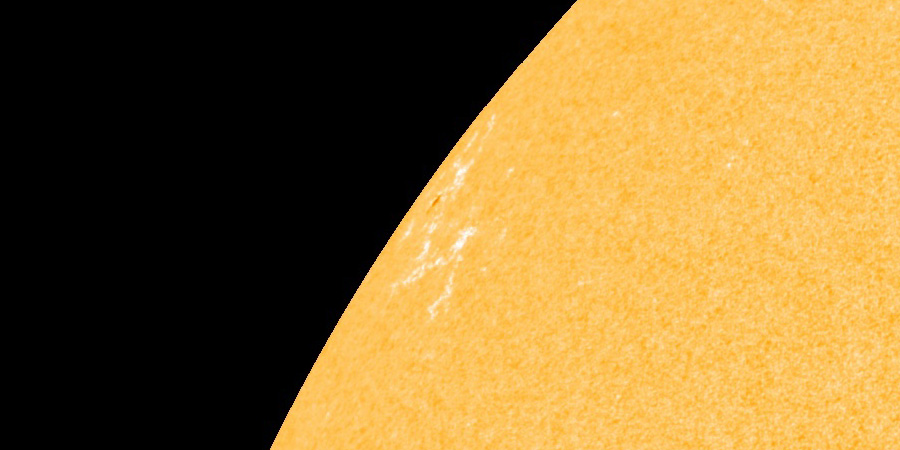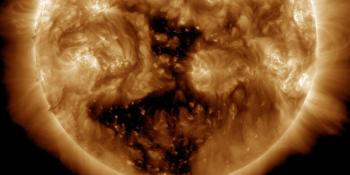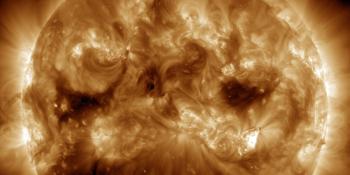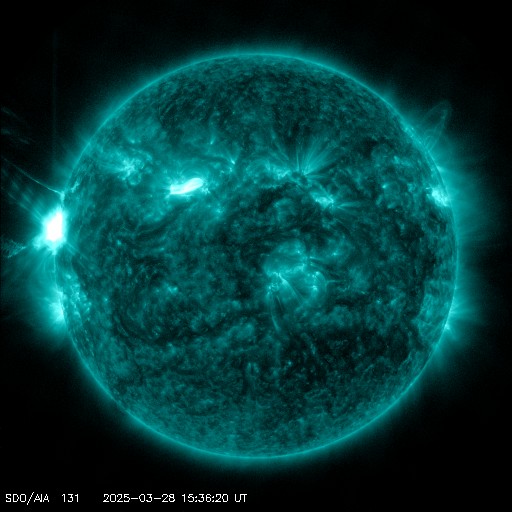Yesterday's M-flare producing active region rotates into view
Saturday, 30 May 2020 13:05 UTC

The sunspot region that was responsible yesterday for what could be the first M-class solar flare of Solar Cycle 25 has now rotated into view.
There isn't much good news to report however. There is only one small sunspot visible surrounded by faculae which indicates that this sunspot region has been in decay. More M-class activity from this sunspot region seems unlikely.
Were also seeing a slight increase in geomagnetic activity at Earth. The interplanetary magnetic field strength is moderate at the moment and this morning the Bz managed to dip below -10nT at times. This could be a weak glancing blow from a coronal mass ejection that left the Sun a couple of days ago. The Kp index maxed out at 3 but it does not seem likely that we will reach active geomagnetic conditions (Kp4) at the moment as the Bz turned northward. Do follow the data live on our website in case conditions change in the hours ahead.
Thank you for reading this article! Did you have any trouble with the technical terms used in this article? Our help section is the place to be where you can find in-depth articles, a FAQ and a list with common abbreviations. Still puzzled? Just post on our forum where we will help you the best we can!
Current data suggests there is a slight possibility for aurora to appear at the following high latitude regions in the near future
NorilskLatest news
Latest forum messages
Support SpaceWeatherLive.com!
A lot of people come to SpaceWeatherLive to follow the Sun's activity or if there is aurora to be seen, but with more traffic comes higher server costs. Consider a donation if you enjoy SpaceWeatherLive so we can keep the website online!

Latest alerts
15:45 UTC - 10cm Radio Burst
Begin Time: 28/02/2025 15:06 UTC Maximum Time: 28/02/2025 15:14 UTC Duration: 24 minutes. Peak flux: 380 sfu
15:45 UTC - Type IV Radio Emission
Begin Time: 28/03/2025 15:14 UTC
15:42 UTC - Solar flare
Major X1.14 flare from sunspot region 4046
15:21 UTC - Radio Blackout
Strong R3 radio blackout in progress (≥X1 - current: X1.08)
15:18 UTC - Radio Blackout
Moderate R2 radio blackout in progress (≥M5 - current: M6.33)
Space weather facts
| Last X-flare | 2025/02/23 | X2.0 |
| Last M-flare | 2025/03/27 | M2.0 |
| Last geomagnetic storm | 2025/03/27 | Kp5 (G1) |
| Spotless days | |
|---|---|
| Last spotless day | 2022/06/08 |
| Monthly mean Sunspot Number | |
|---|---|
| February 2025 | 154.6 +17.6 |
| March 2025 | 130 -24.6 |
| Last 30 days | 130 -22.2 |



